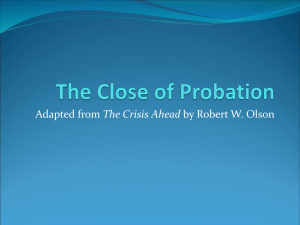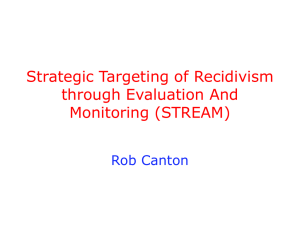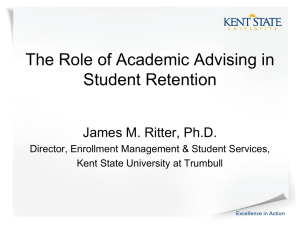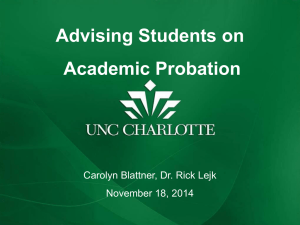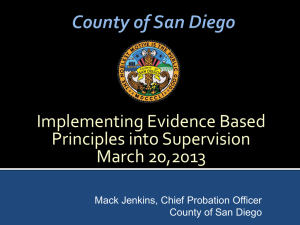Chapter 4 - Peru State College
advertisement
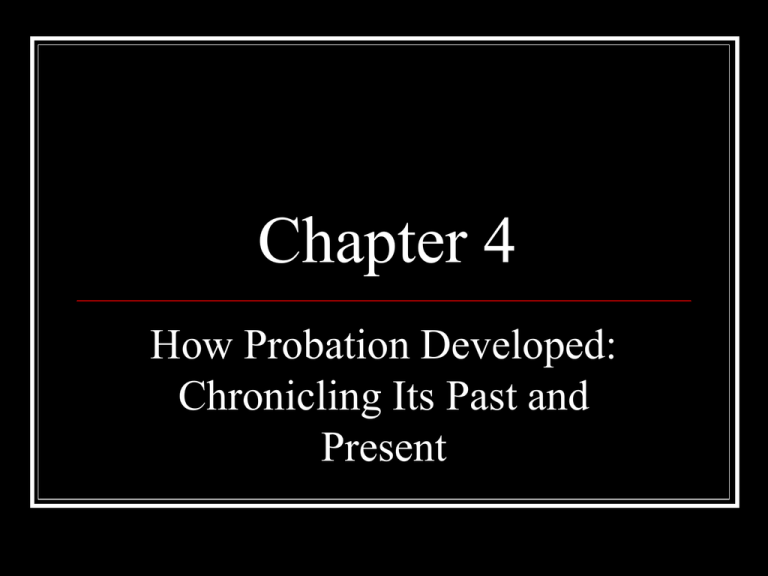
Chapter 4 How Probation Developed: Chronicling Its Past and Present Precursors to American Probation Early legal practice in the United States was distinct from British common law: Security for good behavior, good abearance Filing Motion to Quash Sureties All had the objective of mitigating punishment. LO: 1 Recognizance and Suspended Sentence Recognizance began in 1830 in Commonwealth v. Chase. A suspended sentence is a court order, entered after a verdict, finding, or plea of guilty, that suspends or postpones the sentence contingent on the good behavior of the offender. LO: 1 Two Kinds of Suspended Sentences Suspension of imposition of sentence occurs when a verdict or plea is reached, but no sentence is pronounced and there is no conviction. In suspension of execution of sentence, the defendant is placed on probation and the conviction remains on the record. LO: 1 The Power to Suspend Sentence English common law courts had the power to suspend sentence for a limited period or for a specific purpose. The common practice of suspension in the federal courts ended with the Killits decision in 1916. The Federal Sentencing Reform Act in 1984 recognized probation as a bona fide sentence. LO: 1 Founders of Probation The first probation law was passed in Massachusetts in 1878. John Augustus receives credit for founding probation in the United States. In 1891 in Massachusetts, probation officers were first recognized as official salaried agents of the court. LO: 2 Early Probation Matthew Davenport Hill receives credit as a cofounder of probation for laying the foundation in England. Historically, federal judges were resistant to the enactment of federal probation legislation. The National Probation Act was passed by Congress in 1925. LO: 2 Federal Probation The federal probation system was administered by the Federal Bureau of Prisons from 19301940. In 1940, administration of the system moved to the Administrative Office of the U.S. Courts. The 1984 Comprehensive Crime Control Act abolished federal parole and all releasees came under probation supervision. LO: 2 Juvenile Probation & Juvenile Court From the 1700’s-early 1800’s, children were disciplined by their parents and other adults in the community. Between 1817-mid 1840’s, “child savers” institutionalized runaway or neglected children. The Illinois Juvenile Court Act of 1899 established the first juvenile system based on reformation and treatment. LO: 3 Juvenile Probation & Juvenile Court, Con’t. The doctrine of parens patriae governed juvenile court proceedings, using four principles: 1. The court appointed a guardian to care for the child 2. Parents of offenders must be held responsible 3. Jail was unsuitable, regardless of offense 4. Removing children from their parents should be avoided LO: 3 Early Probation Legislation in Other States New York’s probation law allowed police officers to be probation officers. Many early probation workers were volunteers due to the lack of appropriations. The adoption of probation laws by the various states utilized both county and state organizational models. LO: 4 Organizational Questions What branch of government does the probation agency fall under: executive/state or judicial/local? Is the probation agency combined with parole, or is it a standalone department? Does the agency combine their adult and juvenile supervision together, or are they separate? LO: 4 Community Corrections Acts Community Corrections Acts (CCAs) are statewide agreements through which funds are granted to local governments to develop and deliver community correctional sanctions and services. The first community corrections act was enacted in Minnesota in 1973, and they now exist in 28 states. LO: 5 Changing Concepts of Supervision The Casework Model: 1900-1970 Provided therapeutic services to clients to assist them in living productively in the community Brokerage of Services Model: 1970-1980 The officer determines the needs of the probationer or parolee and makes a referral to the appropriate community agency LO: 3 Changing Concepts of Supervision, Con’t. Community Resource Management Team Individual officers specialize in specific treatment areas, i.e., drug abuse, employment, etc. Justice Model of Supervision: 1980-1995 Some degree of deprivation of liberty Reparation to the victim or community Emphasis on Public Safety LO: 3
